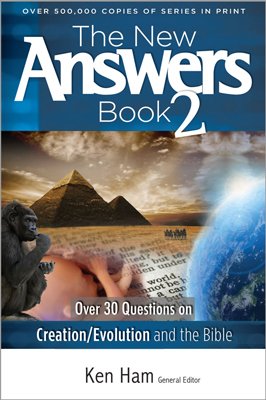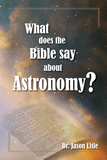
Chapter 4
Does the Bible Say Anything about Astronomy?
The Lord certainly understands how this universe works; after all, He made it. So His Word, the Bible, gives us the foundation for understanding the universe.
The Bible is the history book of the universe. It tells us how the universe began and how it came to be the way it is today.
The Bible is much more than just a history book, however; it was written by inspiration of God. The Lord certainly understands how this universe works; after all, He made it. So His Word, the Bible, gives us the foundation for understanding the universe.
It has been said that the Bible is not a science textbook. This is true, of course, and it’s actually a good thing. After all, our science textbooks are based on the ideas of human beings who do not know everything and who often make mistakes. That’s why science textbooks change from time to time, as people discover new evidence and realize that they were wrong about certain things.
The Bible, though, never changes because it never needs to. God got it right the first time! The Bible is the infallible Word of God. So when it touches on a particular topic, it’s right. When the Bible talks about geology, it’s correct. When Scripture addresses biology or anthropology, it’s also right.
What does the Bible teach about astronomy? Let’s take a look at some of the things the Bible has to say about the universe. We will see that the Bible is absolutely correct when it deals with astronomy.
The Earth Is Round

The Bible indicates that the earth is round. One verse we can look at is Isaiah 40:22, where it mentions the “circle of the earth.” From space, the earth always appears as a circle since it is round. This matches perfectly with the Bible.
Another verse to consider is Job 26:10, where it teaches that God has “inscribed” a circle on the surface of the waters at the boundary of light and darkness. This boundary between light and darkness is where evening and morning occur. The boundary is a circle since the earth is round.
The Earth Floats in Space
- The Hindus believe the earth to be supported on the backs of four elephants, which stand on the shell of a gigantic tortoise floating on the surface of the world’s waters.
- The earth of the Vedic priests was set on 12 solid pillars; its upper side was its only habitable side.
- The Altaic people of Northern Siberia affirm that their mighty Ulgen created the earth on the waters and placed under it three great fish to support it.
- The Tartars and many of the other tribes of Eurasia believe the earth to be supported by a great bull.
A very interesting verse to consider is Job 26:7, which states that God “hangs the earth on nothing.” This might make you think of God hanging the earth like a Christmas tree ornament, but hanging it on empty space. Although this verse is written in a poetic way, it certainly seems to suggest that the earth floats in space; and indeed the earth does float in space. We now have pictures of the earth taken from space that show it floating in the cosmic void. The earth literally hangs upon nothing, just as the Bible suggests.
The Expansion of the Universe
The Bible indicates in several places that the universe has been “stretched out” or expanded. For example, Isaiah 40:22 teaches that God stretches out the heavens like a curtain and spreads them out like a tent to dwell in. This would suggest that the universe has actually increased in size since its creation. God is stretching it out, causing it to expand.
Now, this verse must have seemed very strange when it was first written. The universe certainly doesn’t look as if it is expanding. After all, if you look at the night sky tonight, it will appear about the same size as it did the previous night, and the night before that.
In fact, secular scientists once believed that the universe was eternal and unchanging. The idea of an expanding universe would have been considered nonsense to most scientists of the past. So it must have been tempting for Christians to reject what the Bible teaches about the expansion of the universe.
I wonder if any Christians tried to “reinterpret” Isaiah 40:22 to read it in an unnatural way so that they wouldn’t have to believe in an expanding universe. When the secular world believes one thing and the Bible teaches another, it is always tempting to think that God got the details wrong. But God is never wrong.
Most astronomers today believe that the universe is indeed expanding. In the 1920s, astronomers discovered that virtually all clusters of galaxies appear to be moving away from all other clusters; this indicates that the entire universe is expanding.
You can think of this like points on a balloon. As the balloon is inflated, all the points move farther away from each other. If the entire universe was being stretched out, the galaxies would all be moving away; and that is what they actually appear to be doing.
It is fascinating that the Bible recorded the idea of an expanding universe thousands of years before secular science came to accept the idea.
The Age of the Universe
Scripture also addresses the age of the universe. The Bible teaches that the entire universe was created in six days (Exodus 20:11). We know from the genealogies and other events recorded in Scripture that this creation happened about 6,000 years ago.
Yet, this is quite different from what most schools teach. Most secular scientists believe that the universe is many billions of years old, and they usually hold to the big bang theory. The big bang is a secular speculation about the origin of the universe; it is an alternative to the Bible’s teaching. The big bang attempts to explain the origin of the universe without God (see the next chapter, “Does the Big Bang Fit with the Bible?”).
People who believe in the big bang usually interpret the evidence according to their already-existing belief in the big bang.
People who believe in the big bang usually interpret the evidence according to their already-existing belief in the big bang. In other words, they just assume that the big bang is true; they interpret the evidence to match their beliefs. Of course, the Bible can also be used to interpret the evidence. And since the Bible records the true history of the universe, we see that it makes a lot more sense of the evidence than the big bang does.
Now let’s look at some facts about the universe regarding its age. We will see that the evidence is consistent with 6,000 years but doesn’t make sense if we hold to the big bang.
Of course, big bang supporters can always reinterpret the evidence by adding extra assumptions. So the following facts are not intended to “prove” that the Bible is right about the age of the universe. The Bible is right in all matters because it is the Word of God. However, when we understand the scientific evidence, we will find that it agrees with what the Bible teaches. The evidence is certainly consistent with a young universe.
Recession of the Moon
The moon is slowly moving away from the earth. As the moon orbits the earth, its gravity pulls on the earth’s oceans, which causes tides. The tides actually “pull forward” on the moon, causing the moon to gradually spiral outward. So the moon moves about an inch and a half away from the earth every year. That means that the moon would have been closer to the earth in the past.

For example, 6,000 years ago, the moon would have been about 800 feet closer to the earth (which is not much of a change, considering the moon is a quarter of a million miles away). So this “spiraling away” of the moon is not a problem over the biblical time scale of 6,000 years. But if the earth and moon were over four billion years old (as evolutionists teach), then we would have big problems. In this case, the moon would have been so close that it would actually have been touching the earth only 1.4 billion years ago. This problem suggests that the moon can’t possibly be as old as secular astronomers claim.
Secular astronomers who assume that the big bang is true must use other explanations to get around this. For example, they might assume that the rate at which the moon was receding was actually smaller in the past. But this is an extra assumption needed to make their billions-of-years model work. The simplest explanation is that the moon hasn’t been around for that long. The recession of the moon is a problem for a belief in billions of years but is perfectly consistent with a young age.
Magnetic Fields of the Planets
Many of the planets of the solar system have strong magnetic fields. These fields are caused by electrical currents that decay with time. We can even measure this decay of the earth’s magnetic field: it gets weaker and weaker every year. If the planets were really billions of years old (as evolutionists believe), then their magnetic fields should be extremely weak by now. Yet they are not. The outer planets of the solar system, in particular, have quite strong magnetic fields. A reasonable explanation for this is that these planets are only a few thousand years old, as the Bible teaches.
Spiral Galaxies
A galaxy is an enormous assembly of stars, interstellar gas, and dust. The galaxy in which we live is called the Milky Way; it has over 100 billion stars. Some galaxies are round or elliptical. Others have an irregular shape, but some of the most beautiful galaxies are spiral in nature, such as our own. Spiral galaxies slowly rotate, but the inner regions of the spiral rotate faster than the outer regions. This means that a spiral galaxy is constantly becoming more and more twisted up as the spiral becomes tighter. After a few hundred million years, the galaxy would be wound so tightly that the spiral structure would no longer be recognizable. According to the big-bang scenario, galaxies are supposed to be many billions of years old. Yet we do see spiral galaxies — and lots of them. This suggests that they are not nearly as old as the big bang requires. Spiral galaxies are consistent with the biblical age of the universe but are problematic for a belief in billions of years.

NASA/ESA
Comets
Comets are balls of ice and dirt. Many of them orbit the sun in elliptical paths. They spend most of their time far away from the sun, but occasionally they come very close to it. Every time a comet comes near the sun, some of its icy material is blasted away by the solar radiation. As a result, comets can orbit the sun for only so long (perhaps about 100,000 years at most) before they completely run out of material. Since we still have a lot of comets, this suggests that the solar system is much younger than 100,000 years; this agrees perfectly with the Bible’s history.
Yet, secular astronomers believe the solar system is 4.5 billion years old. Since comets can’t last that long, secular astronomers must assume that new comets are created to replace those that are gone. So they’ve invented the idea of an “Oort cloud.” This is supposed to be a vast reservoir of icy masses orbiting far away from the sun. The idea is that occasionally an icy mass falls into the inner solar system to become a “new” comet. It is interesting that there is currently no evidence of an Oort cloud. And there’s no reason to believe in one if we accept the creation account in Genesis. Comets are consistent with the fact that the solar system is young.
Supernatural Creation
Aside from age, there are other indications that the universe was supernaturally created as the Bible teaches. These evidences show God’s creativity — not a big bang. For example, astronomers have discovered “extrasolar” planets. These are planets that orbit distant stars, not our sun. Some of these exoplanets have been observed directly when they transit their star, but there are some exoplanets that have not been directly observed. Instead, they have been detected indirectly, usually by the gravitational “tug” they produce on the star they orbit. But the principles being used here are all good “operational science,” the kind of testable, repeatable science that can be done in a laboratory. So we have every reason to believe that these are indeed real planets that God created.
These extrasolar planets are actually a problem for big-bang evolutionary models of solar system formation. Secular astronomers had expected that other solar systems would resemble ours, with small planets forming very closely to their star, and large planets (like Jupiter and Saturn) forming farther away. But many of these extrasolar planets are just the opposite; they are large, Jupiter-sized planets orbiting very closely to their star. This is inconsistent with evolutionary models of solar system formation, but it’s not a problem for biblical creation. God can create many different varieties of solar systems, and apparently He has done just that.
Conclusion
We have seen that when the Bible addresses the topic of astronomy, it is accurate in every aspect. This shouldn’t be surprising, because the Bible, which teaches that the heavens declare the glory and handiwork of God (Psalm 19:1), is the written Word of the Creator. God understands every aspect of the universe He has created, and He never makes mistakes.
In addition, the Word of God provides the correct foundation for understanding the scientific evidence. At the same time, the Bible provides more than just information on the physical universe. It also answers the most profound questions of life. Why are we here? How should we live? What happens when we die? The Word of God even answers the question of why there is death and suffering in the world.1
We can have confidence that what the Bible says about our need for salvation is true, because the Bible has demonstrated itself to be accurate time after time. Showing our children how true science confirms the Bible will help them answer the evolutionary attacks they encounter at schools and in the media.
The New Answers Book 2
In The New Answers Book 2 you’ll find 31 more great answers to big questions for the Christian life.
Read Online Buy BookFootnotes
Recommended Resources

Answers in Genesis is an apologetics ministry, dedicated to helping Christians defend their faith and proclaim the good news of Jesus Christ.
- Customer Service 800.778.3390
- Available Monday–Friday | 9 AM–5 PM ET
- © 2025 Answers in Genesis




